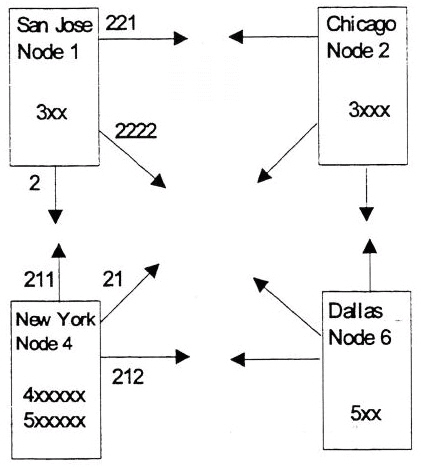
The following examples illustrate various ways of configuring network addressing to meet the needs of different networks.
A network consists of four nodes: San Jose (Node 1), Chicago (Node 2), New York (Node 4) and Dallas (Node 6). Before the NP Net optional feature was installed, the San Jose node had three digit local mailboxes that began with digits 3 through 8. If the administrator wants to retain this structure, she can use dialing plan position 9 for remote mailboxes. The following changes makes this possible:
The old San Jose dialing plan of 0,0,3,3,3,3,3,3,0 is changed to 0,0,3,3,3,3,3,3,N5.
The access codes for all remote nodes begin with 9
Each prefix has a digits to absorb count of 2
The Digits Translation Table for San Jose looks like this:
Node Node Digits
To |
The access code length depends on how many number combinations are needed to cover all the nodes on the system, but the codes should not be so long that it is a chore for users to send remote messages. In the example above, the access codes can be up to 8 digits, since mailbox numbers can be up to 11 digits, but it is unreasonable to expect system users to remember 8 digit access codes and 3 digit mailbox numbers. A very large network would require more positions for remote nodes to make this scheme workable.
This method is useful for NuPoint Unified Messaging servers like the one in the example, where NP Net software is installed on an established system that has a pool of users who have memorized many mailbox numbers and do not want them to change. It is also practical for NuPoint Unified Messaging servers on which both NP Net and NP Receptionist are installed. Mailbox numbers can match NP Receptionist extension numbers without regard to the extension/mailbox structures of other nodes.
Suppose one has the network shown below. The Chicago node (Node 2) has four digit mailboxes that start with 3, the New York node (Node 4) has six digit mailboxes starting with 4 or 5, and the Dallas node (Node 6) has three digit mailboxes that start with 5. Optimally, all these mailboxes must be served by the same dialing plan position. The access codes for all remote nodes can still begin with 9, as that digit is not part of any existing dialing scheme. Let’s analyze each node individually:

Users on the San Jose node would like to enter the same number of digits to send messages to mailboxes on any of these three remote nodes, even though the destination mailbox numbers have different lengths. A digits absorbed count for each prefix is suddenly very useful. Since New York remote mailboxes already have six digits, the administrator decides that users will only need to enter a one digit access code (i.e. 9) to reach New York. The digits to absorb count for the New York node is 1. The prefixes listed for New York in the Digits Translation Table must include at least the first digit of all possible valid mailbox numbers on the node, to make all mailboxes accessible, and to make all prefixes unique. The dialing plan in San Jose is changed to 0,0,3,0,0,0,0,0,N7 to accommodate the New York node. Local mailboxes are unaffected by the change.
To access the four-digit mailboxes on the Chicago node, the Digits Translation Table must have three digit prefixes (access codes) to conform with the seven-digit network dialing plan (three digit access code plus a four digit extension equals seven digits). The digits to absorb count is also 3 for all Chicago prefixes.
The Dallas node uses three-digit mailboxes, so it needs a four digit access code to conform with the dialing plan. The digits to absorb count is 4 for all Dallas prefixes.
San Jose Digit Translation Table
Node Node Digits
To
Prefix Number Name Absorb
221 2 Chicago 3
2222 6 Dallas 4
24 4 New
York 1
25 4 New
York 1
The administrators for the New York, Chicago, and Dallas nodes all decide that users on their servers will address network messages with a prefix digit, a node access code, and variable length mailbox numbers. This simplifies their system planning and maintenance.
All three sites use 9 as the network prefix digit, so the dialing plan for New York is
The Digit Translation Tables for all three nodes look follow the same pattern. The table for New York is shown below.
Node Node Digits
To
Prefix Number Name Absorb
1 1 San
Jose 1
2 2 Chicago 1
6 6 Dallas 1
When a user in New York wants to address a message to mailbox 325 in San Jose, he enters 91325. The New York node recognizes the address as a network address and strips off the 9 because of the P character in the dialing plan. It then compares the remaining digits with the prefixes in the Digits Translation Table and finds that the message is for San Jose. When the San Jose node receives the message, it strips off one digit and delivers the message to mailbox 325.
![]()